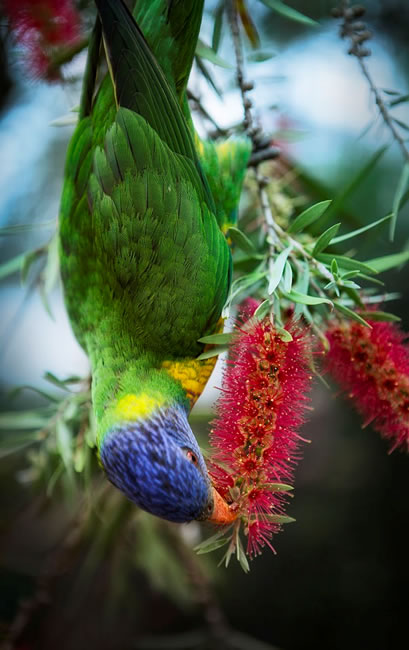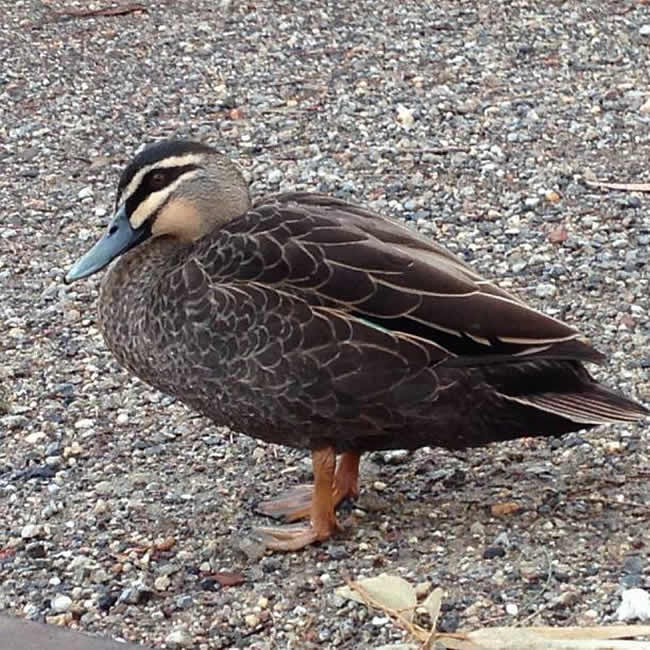Australian birds … not just native birds, but introduced species as well. They too make up the ecology we live in today. If anything birds are even more challenging to photograph than other animals – they move more quickly, change direction more rapidly. It takes patience, being ready at just the right time. Koole Imaging has a selection of pictures of birds found in Australia on this page. It’s a privilege to share his pics here.

Koole Imaging is based in Queensland, in the harbour city of Gladstone. He says, among other things
‘…Australia is an amazing diverse country too beautiful not to share with the world! … ‘
ThisisAustralia.com.au has permission to share them on our pages too. We do so with appreciation.
All Koole Imaging photos are Copyright © Koole Imaging.

Copyright © Koole Imaging
The three birds were leaving the feed bowl at the same time yet it appears to be a time lapse photo of one bird. Gin Gin, Queensland, Australia.
It’s a great shot! I don’t know what type of birds these are. Can someone let us know?

Copyright © Koole Imaging
King parrots are a large, brilliantly coloured birds that live in much of eastern Australia – but not in Tasmania – in wet and coastal environments. They tend to like dense bushland. They feed on seeds, fruit, berries, nuts, nectar, blossoms, leaf buds, and insects and their larvae.
________________________________
How to use self adhesive labels? Click here for self adhesive paper labels info: Labels Information Page – Everylabels.com.au
________________________________
More info on King Parrots can be found at Australia Zoo

Copyright © Gail Beerman Used by permission and with appreciation.
Rainbow Lorikeets live in coastal regions across northern and eastern Australia. The local population in Perth, Western Australia, is a result of birds being released from aviaries. The Rainbow Lorikeet lives in places where there are trees, including rainforest and woodlands, as well as in towns where there are trees.
More info on Rainbow Lorikeets can be found at Birds in Backyards

Copyright © Koole Imaging
They are noisy and conspicuous birds, living in lightly timbered woodlands with a grassy understorey, tree-lined watercourses and agricultural lands.
________________________________
How to use self adhesive labels? Click here for self adhesive paper labels info: Labels Information Page – Everylabels.com.au
________________________________
More info on Pale headed Rozellas can be found at Bird Life Australia

Copyright © Koole Imaging
Pink and grey galahs are gregarious birds, living in flocks of 30 to as much as one thousand birds. They are found all through the Australian bush and the outback. They make their nests in hollow trees or logs.
Australia large map. Great planning map!

Copyright © Willem Schultink
This one was photographed in the sandhills near the beach at Eucla, in Western Australia, near the border of South Australia.
More info on Pink and Grey Galahs can be found at The Australian Galah

Copyright © Koole Imaging

Copyright © Koole Imaging
The Southern Cassowary is the third tallest and second heaviest living bird, smaller only than the ostrich and emu. They are part of the ratite group of birds, which includes the ostrich and the emu. They are very shy birds, but when they are provoked they have been known to attack both humans and animals. They are native to northern Australia, tropical forests in New Guinea, and surrounding islands.
More info on Cassowaries can be found at Perth Zoo

Copyright © Koole Imaging
More info on the Australian Pelican can be found at Perth Zoo

Copyright © Koole Imaging
I wonder what is happening with those two birds together. I don’t know what sort of birds they are. Perhaps someone could let us know?

Copyright © A&N Schultink

Copyright © A&N Schultink
Friendly – near enough to touch! This pic was not taken with a DSLR with a long lens, but with a mobile phone. You have get close up to get a good pic.
Australia large map. Great planning map!

Copyright © A&N Schultink

Copyright © Koole Imaging
They are part of the ratite group of large flightless birds, which includes the ostrich and the cassowary.
Emus can move very quickly. I once had an old man emu running alongside the car on the Eyre Highway a few miles east of Norseman in Western Australia. He was a big powerful bird and he matched the car’s speed of a bit more than 60 kilometres and hour for a short distance, before he decided that the scrub was a better option! It was beautiful to see him run, with his feathers flowing in the wind and his body seeming to flow over the ground.
Watch John Williamson sing a humorous song about Old Man Emu in this old black and white clip from the 1970s:
This page Copyright © ThisisAustralia.au


All the labels you use every day, with excellent service! EveryLabels.com.au
Australia large map. Great planning map!

